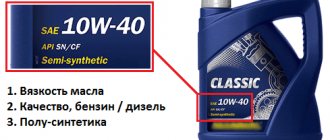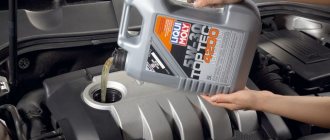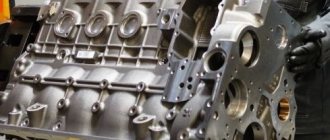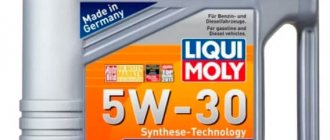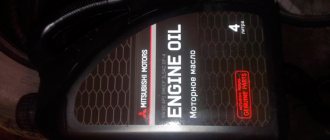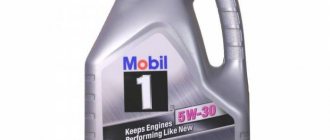Density of vegetable oils depending on temperature
The table shows the density values of vegetable oils depending on temperature in the range from -20 to 150°C. The density of the following vegetable oils is indicated : grape seed oil, corn oil, sesame oil, sunflower oil from sunflower seeds No. 8931, refined sunflower, Amur and refined soybean oil, cottonseed oil from cotton seeds No. 108, edible straw from sunflower oil and cottonseed oil.
The density of vegetable oils at room temperature varies from 850 to 935 kg/m3. The table shows that when the oil is heated, its density decreases. It should be noted that the density of these oils is less than this value for water even at negative oil temperatures (-20°C).
The lightest oil considered here is unrefined sunflower oil - the density of sunflower oil is 916 kg/m3 at a temperature of 20°C.
Engine oil viscosity
Viscosity is the property of a liquid to resist when its layers move under the influence of an external force. This property is a consequence of the friction that occurs between the molecules of the liquid. The viscosity of the oil determines its ability to provide hydrodynamic friction in bearings. Oil viscosity affects the wear of the crankshaft journals and bearing shells. The amount of heat removed from the friction unit depends on the viscosity of the oil. The lower the viscosity, the better the bearing is cooled, since more oil is pumped through it, and therefore more heat is removed with it from the friction zone.
Kinematic viscosity
Kinematic viscosity shows the fluidity of engine oil at normal (40°C) and high (100°C) temperatures. For measurement, a glass viscometer is used: the time during which the oil flows through the capillary at a given temperature is measured. The unit of measurement is mm2/s.
Viscosity index
Viscosity Index (VI, Viscosity Index, VI) is an indicator that characterizes the change in viscosity of motor oil depending on temperature. The index is calculated using kinematic viscosity values at 40 and 100 degrees Celsius. The higher this indicator, the less the oil loses viscosity with temperature changes and the greater the range of operating temperatures it has.
Dynamic viscosity
Dynamic viscosity is the level of resistance at different distances when a fluid moves at a certain speed. This viscosity level is measured on special machines that simulate the process of oil operation in real conditions.
CCS (Cold Cranking Simulator)
Dynamic viscosity, showing the ability to crank the engine crankshaft at subzero temperatures. Determined on a cold start simulator. Measurement method - ASTM D 2602, DIN 51 377.
MRV (Mini Rotary Viscometer)
The test is carried out on a mini-rotational viscometer at a temperature 5°C lower than CCS to ensure that the oil pump will not pump air. The indicator indicates whether the oil pump can pump thickened oil. Measurement method: ASTM D 3829.
HTHS (High Temperature High Shear)
Oil viscosity depends on a large number of external factors such as pressure, temperature and shear rate. HTHS determines the viscosity of engine oil at high temperature and high shear rate (measurement method - ASTM D4683).
Shear rate is the intensity of change in the speed of one flow layer relative to the second. The value is expressed in reciprocal seconds [1/s]. In an engine, the motor fills the gaps between two surfaces that move at high speed relative to each other (for example, a piston and a cylinder). During this process, layers of liquid (motor oil) slide.
Synthetic base oils are quite liquid. They provide excellent performance at low temperatures, but become very thin at high temperatures. Therefore, in order to avoid strong dilution at operating temperature, polymer viscosity modifiers are added to modern all-season motor oils, which compress/expand when temperature changes, bringing the characteristics of base oils to the required values. Oil itself is a Newtonian fluid, that is, its characteristics are linearly dependent. However, when viscosity modifiers are added, motor oil no longer behaves like a Newtonian fluid. At high shear rates, the polymers align in the direction of flow and are compressed, causing the oil to thin out. In addition, some polymers simply collapse at high shear rates (star-shaped - less, linear - more), and the fluidity characteristics of such liquids somewhat lose “linearity” depending on temperature.
The work of polymer thickeners - viscosity modifiers.
Concerned with this problem, engineers decided to introduce a parameter that would show the viscosity of the oil under dynamic conditions. This is how the concept of HTHS (high temperature high shear) was introduced.
The HTHS parameter determines the viscosity of the oil at high temperature (150°C) and high shear rate of 106 s-1, i.e. under conditions close to engine operation. Measured in mPa*s. Determined on a tapered bearing simulator.
| HTHS value | Oil category according to ACEA |
| HTHS ≤3.5 mPa-s | oil categories A3/B4, C3, C4, E4, E6, E7, E9 |
| HTHS ≥2.9 and ≤3.5 mPa-s | oil of categories A5/B5 and A1/B1 and viscosity 5W-30 and 0W-30, as well as C1 and C2. |
| HTHS ≥2.6 and ≤2.9 mPa-s | oils of category ACEA A1/B1 and viscosity 0W-20 / 5W-20 |
| HTHS ≥ 2.4 and ≤2.6 mPa-s | oils with viscosity 0W-16 and 5W-16 |
Table “HTHS of motor oils”
Thus, the higher the HTHS parameter, the thicker the oil and the thicker the oil film.
It's worth noting that a 1989 report by the American Society for Testing and Materials (ASTM) stated that its 12-year effort to develop a new high temperature, high shear (HTHS) standard was unsuccessful. Referring to SAE J300, the basis of current classification standards, the report states:
The rapid rise of non-Newtonian multigrade oils has made kinematic viscosity a virtually useless parameter for characterizing "real" viscosity in critical engine areas. There are those who are disappointed that twelve years of effort have not resulted in the redefinition of the SAE J300 motor oil viscosity classification documentation to express the high temperature viscosity of the various classes. In the author's opinion, this redefinition has not occurred because the automotive lubricant market does not know of a single field failure that is uniquely associated with insufficient HTHS oil viscosity.
What is better, the average consumer will reasonably ask. There is no answer to this question because it is asked incorrectly. Oil viscosity is prescribed by engineers depending on the gaps between internal combustion engine parts. If you fill the oil thicker than necessary, the oil pump may simply not push the lubricant into the required cavities, which will lead to a wedge (many motorists are familiar with the expression “turned the liners”). Conversely, too thin oil will not create the required film thickness, which will lead to the same consequences.
There is an opinion that the latest liquid oils with low HTHS and viscosity 0w-16, 0w-20 lead to accelerated engine wear. It's a delusion. Such oils contain a large number of anti-wear and extreme pressure additives (based on molybdenum, zinc, etc.), which eliminate metal-to-metal friction. The results of laboratory testing tests prove this. However, it is worth noting that these oils can only be used in those engines and in those operating modes for which they are intended.
Interesting fact. In 1997, the Toyota Research Center conducted a study of the effect of HTHS viscosity on the wear of CPG parts when operating at different temperature conditions. The oils were tested on a Toyota 1.6 DOHC engine. The study showed that when using oils with HTHS below 2.4 mPa-C and at an oil temperature of 90 °C, piston wheel wear increases only if the engine speed exceeds 5000 rpm. But at an oil temperature of 130 °C, a sharp increase in piston ring wear occurs when using oil with an HTHS of 2.6 mPa-C, starting at 2000 rpm, while oils with an HTHS viscosity of 3 mPa-C and above continue to protect the rings even at such high temperatures.
| SAE Viscosity Grade | Crankability (CCS), mPas-s | Pumpability (MRV), mPa-s | Kinemetic viscosity at 100°C, not lower | Kinemetic viscosity at 100°C, not higher | Viscosity HTHS, mPa-s |
| 0W | 6200 at -35°C | 60000 at -40°C | 3.8 | — | — |
| 5W | 6600 at -30°C | 60000 at -35°C | 3.8 | — | — |
| 10W | 7000 at -25°C | 60000 at -30°C | 4.1 | — | — |
| 15W | 7000 at -20°C | 60000 at -25°C | 5.6 | — | — |
| 20W | 9500 at -15°C | 60000 at -20°C | 5.6 | — | — |
| 25W | 13000 at -10°C | 60000 at -15°C | 9.3 | — | — |
| 8 | — | — | 4.0 | 6.1 | 1,7 |
| 12 | — | — | 5.0 | 7.1 | 2,0 |
| 16 | — | — | 6.1 | 8.2 | 2,3 |
| 20 | — | — | 6.9 | 9.3 | 2.6 |
| 30 | — | — | 9.3 | 12.5 | 2.9 |
| 40 | — | — | 12.5 | 16.3 | 2.9* |
| 40 | — | — | 12.5 | 16.3 | 3.7** |
| 50 | — | — | 16.3 | 21.9 | 3.7 |
| 60 | — | — | 21.9 | 26.1 | 3.7 |
* - for viscosity grades 0W-40. 5W-40, 10W-40. ** - for viscosity classes 15W-40, 20W-40, 25W-40, 40
How to store sunflower oil
For judicious use, it is recommended to buy oil in small quantities. This advice applies primarily to the unrefined product, since it is used more slowly but spoils faster. There are general rules that must be followed for all types:
Can:
- store unopened plastic containers;
- pour into a glass bottle;
- place on the shelf of a closed cabinet/balcony.
It is forbidden:
- store near the stove/battery;
- place next to spices/fish/other strong-smelling foods;
- keep in the sun.
Storing oil in the closet and on the balcony
Refined
Refined oil is more stable and stores better than other oils. Due to the lack of taste and aroma, it is universal. Used for preparing hot dishes, dressings, canned food. Refined coconut oil also stores better.
Pros:
- has no foreign odor;
- high shelf life;
- no sediment.
Minuses:
- few nutrients;
- may contain a higher percentage of fat.
Do not buy a refined product that shows obvious signs of exposure to direct sunlight.
Unrefined
It has an active smell and taste - used for salads, cold appetizers, and vegetarian dishes.
Pros:
- lower oil consumption;
- fragrant, healthy.
Minuses:
- spoils quickly - the maximum effective period is one and a half months;
- you need to buy small containers.
Pay attention not only to the production date, but also to the bottling date. If you exceed four months from the date of bottling, you should not purchase the product.
Store exclusively in a dark place: closed cabinet/cellar/pantry. It is better to immediately pour this type of oil into a dark glass vessel with a narrow neck.
Raw sunflower oil should not be used if bitterness and sediment appear.
It is allowed to use an expired product for purposes other than its intended purpose - softening, moisturizing the skin of the hands/face, hair care. Apply it to your skin or mix it with cream. Can also be applied to eyelashes or rubbed onto cuticles. Not suitable for food!
How to store an opened bottle
An opened package of refined, deodorized oil can be stored for a maximum of two months. Subsequently, oxygen oxidizes the product, destroying useful microelements. Such oil can cause significant harm to health, including the occurrence of cancer.
Unrefined wine cannot be stored in an opened bottle for longer than 14 days. Therefore, it is recommended to buy small bottles and open them immediately before use. Olive oil should be purchased and stored in a small container.
Can it be stored in the refrigerator or freezer?
One-time freezing will not lead to a loss of quality, but will significantly increase the shelf life. After freezing, thickening and cloudiness are possible - this is not a sign of spoilage. When defrosted, the product will return to its original state. Frost retains beneficial properties.
The main advantage of refrigerated storage is that it extends the shelf life of opened packaging.
- Place plastic containers on the middle shelf of the refrigerator/inside the door.
- Check how tightly the lid is closed.
- Store until expiration date.
Do not place on the same shelf with strong-smelling foods, such as red salted fish, to avoid an unpleasant aftertaste. This is especially true for unrefined oil. Long-term freezing is unacceptable for it; its beneficial properties soon disappear and the product is only suitable for frying.
How to restore lubricant fluidity or warm up the engine crankcase before starting
Let's start with the fact that starting the engine if the oil is frozen is prohibited by any available means. This can lead to damage to the power unit, rotation of the liners, etc. It is quite obvious that when attempting such a start, the frozen oil is not pumped through the channels of the lubrication system and will not be able to create the necessary protective film on the parts.
- The easiest way in such a situation is to deliver the car to a warm garage or parking lot under your own power. If you are sure that the oil in the engine is of high quality, then after warming up the engine, you can start it, then go to a car service center or change the lubricant yourself to a more suitable option, adjusted for current climatic conditions.
- In the list of so-called “old-fashioned” methods, it is worth noting the addition of gasoline or diesel fuel to the oil before overnight parking in winter. This method may also be suitable if it is not possible to immediately change the oil to an analogue with a lower viscosity. Before parking, an average of 150 grams of gasoline or purified diesel fuel is poured into the engine “hot” through the oil filler neck. Thus, the lubricant becomes less viscous. After starting, gasoline evaporates from the oil system and the engine crankcase. This procedure can be repeated before street parking, when maximum cold temperatures are predicted.
Please note that for all its apparent simplicity, this method has one significant drawback - after contact with gasoline, oil loses its beneficial properties. This means that having solved the problem with viscosity, a problem with engine protection inevitably appears after it has warmed up. Adding fuel to the oil for dilution in cold weather leads to significantly increased wear on the CPG and other loaded elements while driving. It turns out that if for an old VAZ classic or unpretentious special equipment using cheap mineral oils this method is still worth considering, then in the case of a more or less technologically advanced engine it is better to forget about such a solution.
Let us add that even if the engine is old, but a good semi-synthetic oil with a package of active additives and other additives was poured into it, the reaction of these additives to gasoline or diesel fuel in the oil can be completely unpredictable (sediment formation, flakes in the oil, etc.) . All this can lead to blockage of the engine lubrication system channels and oil starvation of the engine.
- Another way to solve the problem we are considering is to heat the engine sump with your own hands. In this case, the best solution would be to use an industrial hair dryer. The oil pan warms up for a certain time, after which you should check the oil according to the condition on the dipstick. After fluidity returns, you can try to start the engine. Note that some car enthusiasts use home hair dryers for heating, as well as various types of heaters with closed heating elements.
As practice shows, you can warm up the engine in winter with your own hands in different ways. In some cases, situations are quite common when a gas burner, blowtorch, etc. is used to heat the oil in the engine. Please note that in no case should the pan be allowed to heat up too intensely, since taking into account the sharp temperature difference, serious consequences, cracks and other defects may occur. Remember, during such procedures you must adhere to safety precautions!
What is the smoke point?
The smoke point is the temperature that ensures the formation of volatile compounds under specific conditions. In this case, the amount of these compounds must be sufficient to clearly display the resulting blue smoke. In simple words, this is the temperature at which smoke begins.
When this is achieved, naturally occurring volatile compounds such as free fatty acids and short-chain degradable oxidation elements are removed from the product. These volatile combinations of elements in the atmosphere begin to disintegrate, causing soot to appear.
The smoke point reveals the upper temperature to which you can use a specific vegetable oil or any animal fat for various purposes. When it is reached, the substances begin to break down and can no longer be eaten.
The content of free fatty acids in the products under consideration varies over a fairly wide range.
It will depend on several factors:
- from the origin of the substance;
- on the degree of its refining (purification).
So the smoke point of the oil will be higher with greater refining, as well as with a lower content of free fatty acids.
The latter begin to form during oil heating. The amount of acids formed depends on the duration of heating. When there are a lot of them, the temperature of the smoke point begins to decrease.
You should not use the same product to prepare French fries and other similar dishes more than 2 times. The quality of the oil decreases more rapidly during batch frying than during continuous frying.
If you cook a lot of deep-fried dishes, you can buy a special thermometer to measure the temperature of the oil liquid and check it while heating.
The combustion temperature is significantly higher. This is the point that makes it possible for vapors from the oil to ignite when exposed to the atmosphere.
Thus, oils with a high smoke point can be used for frying. And on substances with a low smoke point - it is strictly not recommended.
Technical characteristics of 5W-40 - decoding
The viscosity index has a direct effect on the temperature under which the lubricant can fully operate. For use in temperate climates, oils are often selected that can work in both summer and winter, and for cold regions they are suitable with a reduced viscosity.
To determine the temperature regime of the technical fluid, subtract the number 30-35 from the first digit of the SAE index, the resulting value will be the lower temperature limit. To derive the maximum limit for the positive temperature of the lubricant, you need to subtract 5 from the second number of the index.
5W-40 is a multi-grade oil that must maintain fluidity at negative and positive temperatures within specified limits in order to qualify for this SAE class. As I have said in other articles, SAE can be an indicator of the climate in which the oil can be used, only partially and only in relation to the low temperature indicator. In general, this is an indication of the viscosity of the oil at different temperatures.
SAE 5W-40 viscosity values table:
| Characteristic | Index | Decoding |
| Pumpability | -35℃ | Minimum temperature at which oil is pumped through the channels |
| Turnability | -30℃ | The minimum temperature at which the engine can be started. |
| Kinematic viscosity at 100 degrees | 12.6-16.3 mm2/s | The indicator must be within these limits for the oil to be labeled 5W-40. |
| Kinematic viscosity at 40 degrees | 89-97 mm2/s | The same thing, but at a different temperature. This indicator is less important than viscosity at operating temperature. |
| Dynamic viscosity CCS at -30 degrees | No more than 6600 mPas | That is, the closer the indicator is to this limit, the worse the crankshaft will turn already at -30 degrees. |
| Flash point | From 224℃ | Can vary +/- 10-15 degrees. |
| Freezing point | About -45℃ | May vary. This indicator indicates the temperature at which the oil will completely freeze and will not be able to be pumped through the channels. |
From this table it is clearly seen that the second two symbols in marking 40 show what viscosity the oil will have exactly at operating temperature, that is, it indicates the thickness of the oil film and how easily and quickly the oil will pass through the system. It is very important to select this indicator according to the manufacturer’s recommendations, since different engines have different design features.
The first number 5 is an indication of low-temperature viscosity, that is, at -30℃ the oil will retain sufficient fluidity to crank the crankshaft.
According to GOST, the oil will be marked 3з/14. According to the API, it most often has a class SN, according to ACEA A1/B1 2010.
Heat capacity of vegetable oils depending on temperature
Specific heat capacity values for vegetable oils are presented at temperatures from -10 to 120°C.
The table shows the heat capacity of the following vegetable oils: grape seed oil, corn oil, sesame oil, sunflower oil from sunflower seeds No. 8931, refined sunflower, Amur soybean, cottonseed oil from cotton seeds No. 108, refined, edible straw from sunflower oil and cottonseed oil , technical straw made from sunflower oil. It should be noted that the heat capacity of vegetable oil increases when heated .
Storage conditions: container, temperature
Preservation of useful substances that are part of the product is possible if the basic rules for its conservation are observed. It is important to maintain the appropriate temperature conditions and protect the container from exposure to sunlight.
Storage features.
Advice! It is important to avoid frying several times in a row due to the fact that repeated heat treatment produces a strong carcinogen.
Oil should be thrown away if there are changes in its color, taste, or cloudiness.
How long can propolis be stored: tincture and dry form?
Mineral motor oil: properties and features
Mineral oils are a viscous liquid consisting of a mixture of high molecular weight hydrocarbons. They are obtained as a result of distillation of petroleum products (or distillation of fuel oil) with mandatory subsequent multi-stage purification. During the distillation of the crude product, the boiling point of the raw material is reached in the range of 300 - 600 ° C, as a result of which the crystalline structure loses its stability.
Technological process for producing mineral oil
One of the most important tasks solved during cleaning is reducing the percentage of sulfur in the base motor oil. Removal of paraffin-containing hydrocarbons and tar is achieved through highly efficient hydrotreating.
The next stage of raw material processing is hydrocracking. It not only allows for in-depth purification of the product, but also changes the length of hydrocarbon chains at the molecular level. As a result, high stability of the purified product is ensured and excellent characteristics of mineral motor oil are achieved.
The process of mineral oil formation does not end there. To increase the physical and mechanical parameters and operational properties, up to 12% of various stabilizing components are introduced into the prepared engine oil base. These multi-component additives improve:
- anti-corrosion properties;
- washing parameters;
- wear resistance.
Main technical characteristics
When choosing mineral oil, many car owners rightfully give preference to products from leading world brands, such as: Lukoil, Lukoil Standard, MOBIL Delvac, LIQUI MOLY. This approach allows you to reduce the likelihood of purchasing a counterfeit product to zero.
The quality parameters of mineral oil (abbreviated as “mineral oil”) are ensured by meeting the following criteria:
- Viscosity. The oil is sequentially heated to temperatures of 40°C and 100°C, after which the path of the product per unit of time is checked.
- Ash content. After combustion of the composition, the remaining ash is determined. It indicates the percentage of additives introduced into the product. Acceptable indicators for gasoline internal combustion engines (ICE) are no more than 1.3%, for diesel engines - 1.8%.
- Base number. Indicates the permissible duration of use, as well as the degree of protection of parts against corrosion.
- Flash point. The indicator at which oil ignites indicates the level of product consumption during operation of the equipment. The lower the value, the higher the consumption of mineral oil.
- Pour point. Shows the conditions under which the oil loses fluidity, which negatively affects the lubrication of internal combustion engine components and parts.
- Cleaning ability. During everyday operation, oil performs an important function: it cleans components and parts in the engine from various blockages, sediment and oxidation products. Reducing the permissible parameters leads to clogged passages, a drop in the power of the power unit, and increased wear.
- Viscosity stability. It is checked by alternating high and low operating temperatures. Minimal changes in characteristics indicate high quality oil.
Scope and features of the use of mineral oils
It is recommended to use mineral oils when the engine has a mileage exceeding 120 - 150 thousand km (depending on the make and model of the vehicle), and there is also a fairly high wear rate of components and parts. Under such conditions, to continue efficient operation of the engine, it is necessary to form a large layer of engine oil. And this can only be achieved by using the natural composition of the lubricant.
Natural oils are recommended for use in diesel engines produced before 2000. When such power units operate, gaps gradually form between the moving and stationary parts in contact, which must be filled with a thick viscous mass.
The quality of a mineral motor lubricant can be determined with a high degree of accuracy by the appearance of the product. The color of the liquid should be light brown with a slight tint of yellow ocher. The more additives and additives a product contains, the higher the color intensity. For this reason, the color scheme of different manufacturers may vary quite significantly. Used oil has a pronounced black color, which is formed as a result of the appearance of soot and leaching of soot.
Right choice
When deciding to use mineral oil in the engine lubrication system, the following parameters must be taken into account:
- Motor type.
- Degree of wear.
- Conditions in which the vehicle is operated.
- Composition and properties of the originally filled oil.
- ICE Operation Manual.
The service life of mineral oils is much shorter compared to other lubricant formulations. That’s why it needs to be changed more often – on average, approximately every 5 – 7 thousand km.
Thermal conductivity of vegetable oils depending on temperature
The table shows the thermal conductivity values of vegetable oils depending on temperature in the range from -20 to 120°C.
The thermal conductivity values of oils such as grape seed oil, corn oil, sesame oil, sunflower oil from sunflower seeds No. 8931, refined sunflower oil, Amur soybean oil, refined cottonseed oil from cotton seeds No. 108, refined straw oil from sunflower oil are given. It should be noted that the thermal conductivity of vegetable oil decreases as its temperature increases .
Ways to extend shelf life
To extend the shelf life of the product at home, use folk recipes.
Add one of the components (optional) to an open bottle (1 l):
The oil is not stirred. Close and put away in a cool, dark place. The shelf life increases by 2-3 months.
Is it possible to store vegetable oil in the cold? To extend the shelf life it is frozen . Only refined products can be frozen. Frozen product is stored for 1 year. It cannot be re-frozen.
To freeze the product, it is poured into plastic bottles or food bags with a zipper. Then put it in the freezer. A good quality product does not harden at sub-zero temperatures, but becomes thick and lighter.
The diluted product freezes and becomes covered with an ice crust . Frozen oil is used in cooking, for dressing salads, and is also used for preparing cosmetics.
Thermal conductivity of some vegetable oils
The table shows the values of the thermal conductivity coefficient of some vegetable oils at temperatures from 4 to 10°C.
The thermal conductivity of the following oils is given: lemon peel oil, nutmeg oil, olive oil, peanut oil, poppy seed oil, sesame oil, sweet almond oil.
Sources:
- Thermophysical characteristics of food products. Directory. Ginzburg A.S. and others. Moscow, 1980. - 288 p.
- Chubik I.A., Maslov A.M. Handbook on the thermophysical characteristics of food products and semi-finished products.

